Click on images to enlarge

large and dense infestation in flower (Photo: Forest and Kim Starr, USGS)
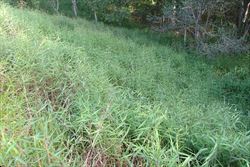
infestation spreading from a roadside into bushland (Photo: Sheldon Navie)

habit (Photo: Sheldon Navie)
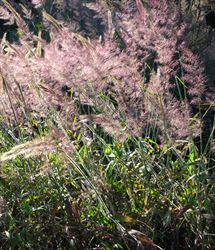
habit in flower (Photo: Forest and Kim Starr, USGS)

leaves (Photo: Sheldon Navie)
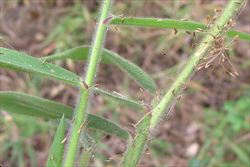
close-up of the stems showing the dense covering of sticky hairs (Photo: Sheldon Navie)

close-up of leaf underside (Photo: Sheldon Navie)

young seed-head (Photo: Sheldon Navie)
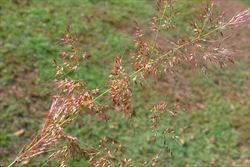
seed-head in flower (Photo: Sheldon Navie)
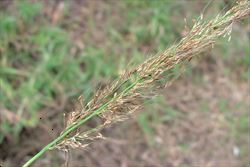
close-up of mature seed-head with seeds (Photo: Sheldon Navie)
Scientific Name
Melinis minutiflora P. Beauv.
Family
Gramineae (South Australia)Poaceae (Queensland, New South Wales, the ACT, Victoria, Tasmania, Western Australia and the Northern Territory)
Common Names
Brazilian stinkgrass, Brazilian stink grass, efwatakala grass, honey grass, melinis, molasses grass, molassesgrass, stink grass, stinkgrass, Whynne grass
Origin
Native to sub-Saharan Africa (i.e. Ethiopia, Somalia, Sudan, Kenya, Tanzania, Uganda, Burundi, Cameroon, Congo, Equatorial Guinea, Rwanda, Zaire, Ivory Coast, Ghana, Guinea, Liberia, Nigeria, Sierra Leone, Togo, Angola, Malawi, Mozambique, Zambia, Zimbabwe, South Africa and Swaziland), Madagascar and the Comoros Islands.
Cultivation
This species has been cultivated as a pasture grass and for erosion control in warmer and wetter areas. However, it is no longer very common in cultivation.
Naturalised Distribution
Widely naturalised, particularly in the warmer parts of eastern Australia. It is most common throughout the coastal districts of eastern Queensland and north-eastern New South Wales. Occasionally naturalised in the northern parts of the Northern Territory, in the coastal districts of south-western and northern Western Australia, and in the coastal districts of central New South Wales. Also naturalised on Lord Howe Island and Norfolk Island.
Widely naturalised overseas in tropical Asia, south-eastern USA (i.e. Florida), tropical Southern America, the Caribbean, La Réunion and many Pacific islands (i.e. in the Galápagos Islands, Fiji, French Polynesia, New Caledonia, Niue, the Wallis and Futuna Islands, Tonga and Hawaii).
Habitat
A weed of roadsides, forest margins, open woodlands, pastures, disturbed sites, waste areas and occasionally also crops (e.g. sugar-cane and rice) in tropical, sub-tropical and warmer temperate regions.
Habit
A long-lived (i.e. perennial) grass usually growing 0.6-1 m tall, but occasionally reaching up to 1.5 m in height. Its upright (i.e. erect), straggling or trailing stems are up to 2 m long, and the flowering stems (i.e. culms) tend to be more upright (i.e. erect or geniculately ascending) and taller.
Distinguishing Features
-
a long-lived grass, usually growing 0.6-1 m tall, with upright, straggling or trailing stems up to 2 m long.
-
its slender stems are hairy and sometimes produce roots where the lower joints come into contact with the soil.
-
its narrow leaves are covered in sticky hairs and tend to be crowded towards ends of the branches.
-
its branched seed-heads (8-30 cm long) are either pale pink, reddish or purplish in colour.
-
these seed-heads bear numerous small flower spikelets (1.5-2.5 mm long), each having one or two small awns (3-15 mm long).
Stems and Leaves
Its stems are slender and sometimes produce roots (i.e. adventitious roots) where the lower joints (i.e. nodes) come into contact with the soil (i.e. it is stoloniferous). These stems are hairy (i.e. pubescent) at the joints (i.e. nodes).
The alternately arranged leaves are generally crowded towards ends of the branches. They consist of a leaf sheath, which partially encloses the stem, and a spreading leaf blade. The leaf sheaths and leaf blades sparsely to densely covered with sticky hairs (i.e. they are glandular pubescent). These hairs exude drops of sticky oil which give the plant a sweet molasses-like odour. The elongated (i.e. linear) leaf blades are flat and taper to a fine point (i.e. acuminate apex). These leaf blades (4-20 cm long and 5-13 mm wide) have entire margins and are often flushed with a purplish or reddish-brown tinge. Where the leaf sheath meets the leaf blade there is a tiny membrane topped with with hairs 0.5-2 mm long (i.e. the ligule is a ciliate membrane).
Flowers and Fruit
The seed-head (i.e. inflorescence) is branched cluster borne at the tips of the flowering stems (i.e. a terminal panicle). These pale pink, reddish or purplish seed-heads (8-30 cm long) are initially rather slender (i.e. with appressed branches), open up when in full flower, and then become rather narrow again as they mature. They consist of numerous small flower spikelets (1.5-2.5 mm long and up to 1.5 mm wide). These flower spikelets have a pair of bracts (i.e. glumes), one of which is much smaller than the other. They also have two tiny flowers (i.e. florets), only one of which produces a seed. There are one or two small awns (3-15 mm long) on each flower spikelet.
As the seed-heads mature they become paler and eventually become brownish in colour. The tiny 'seeds' (i.e. caryopses or grains) are spindle-shaped or oval (i.e. elliptic) in shape and 1.2-1.4 mm long.
Reproduction and Dispersal
It reproduces by its creeping stems which root at the joints (i.e. stolons) and also be seed.
The small and light seeds are wind-dispersed and may also become lodged in clothing, vehicles and animals. Seeds can also be spread in mud and contaminated agricultural produce (i.e. fodder and pasture seed).
Environmental Impact
Molasses grass (Melinis minutiflora) is an environmental weed in Queensland and northern New South Wales. It is also an emerging or potential environmental weed in the northern Territory and Western Australia. This species is also listed as a priority environmental weed in at least one Natural Resource Management region and is thought to pose a significant threat to rangeland biodiversity in northern Australia.
Legislation
Not declared or considered noxious by any state government authorities.
Management
For information on the management of this species see the following resources:
- the Biosecurity Queensland Fact Sheet on this species, which is available online at http://www.dpi.qld.gov.au.
Similar Species
Molasses grass (Melinis minutiflora) is similar to red Natal grass (Melinis repens). These two species can be distinguished by the following differences:
- molasses grass (Melinis minutiflora) is a mat-forming plant with creeping (i.e. stoloniferous) stems and semi-upright (i.e. geniculately ascending) flowering stems. Its flower spikelets are quite small (1.5-2.5 mm long) and mostly hairless, but usually bear a small hair-like awn (0-15 mm long).
- red Natal grass (Melinis repens) is a tufted plant with upright (i.e. erect) or semi-upright (i.e. geniculately ascending) flowering stems. Its flower spikelets are relatively large (2-12 mm long) and densely covered in silky, reddish-coloured, hairs.

